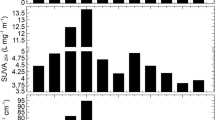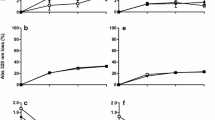Abstract
Biodegradation-induced changes in the characteristics of dissolved organic matter (DOM) and the subsequent effects on disinfection byproduct formation potentials (DBPFPs) were investigated using six different sources of DOM (algae, leaf litter, reed, compost, paddy water, and treated municipal sewage effluent). Microbial incubation of the DOM samples increased the specific ultraviolet absorbance and humic-like fluorescence but decreased the protein/tannin-like fluorescence and relative distribution of smaller-sized DOM components. Comparison of the original versus biodegraded DOM samples using resin fractionation and pyrolysis–gas chromatography/mass spectrometry revealed that the biodegradation-induced changes were highly dependent on DOM sources and exhibited no consistent trends among the different sources. Changes in DBPFPs also differed with DOM source. Vascular plant-derived DOM (leaf litter and reed) demonstrated an enhancement in specific DBPFP after biodegradation, whereas little change or even a slight decrease was observed for the other DOM sources. Correlations that were significant between specific DBPFPs and the aromatic content or humic-like fluorescence for the original DOM samples were no longer significant after microbial degradation. The relative abundance of hydrophobic to hydrophilic structures in DOM is suggested to be a general indicator for the formation potential of trihalomethanes irrespective of DOM source and the state of biodegradation.




Similar content being viewed by others
References
Amon RMW, Benner R (1996) Bacterial utilization of different size classes of dissolved organic matter. Limnol Oceanogr 41:41–51
APHA (American Public Health Association), AWWA (American Water Works Association), and WEF (Water Environment Federation) (2005) Standard methods for the examination of water and wastewater, 20th edn. Washington DC, USA: Method 6-41, 6-47
Asakawa D, Mochizuki H, Yanagi Y, Fujitake N (2007) Characterization of hydrophobic acid fractions in water-soluble organic matter in Dystric Cambisol and a stream in a small forested watershed: seasonal and vertical variations in chemical properties. Soil Sci Plant Nutri 53:551–561
Baker A (2001) Fluorescence excitation-emission matrix characterization of some sewage-impacted rivers. Environ Sci Technol 35:948–953
Beggs KMH, Summers RS (2011) Character and chlorine reactivity of dissolved organic matter from a mountain pine beetle impacted watershed. Environ Sci Technol 45:5717–5724
Biers EJ, Zepp RG, Moran MA (2007) The role of nitrogen in chromophoric and fluorescent dissolved organic matter formation. Mar Chem 103:46–60
Bruchet A, Rousseau C, Mallevialle J (1990) Pyrolysis-GC-MS for investigating high molecular weight THM precursors and other refractory organics. J Am Water Works Ass 82:66–74
Chen ZQ, Hu CM, Comny RN, Muller-Karger F, Swarzenski P (2007) Colored dissolved organic matter in Tampa Bay, Florida. Mar Chem 104:98–109
Chen C, Zhang XJ, Zhu LX, Liu J, He WJ, Han HD (2008) Disinfection by-products and their precursors in a water treatment plant in North China: seasonal changes and fraction analysis. Sci Tot Environ 397:140–147
Chen B, Nam S-N, Westerhoff PK, Krasner SW, Amy G (2009) Fate of effluent organic matter and DBP precursors in an effluent-dominated river: a case study of wastewater impact on downstream water quality. Water Res 43:1755–1765
Chow AT, Gao S, Dahlgren RA (2005) Physical and chemical fractionation of dissolved organic matter and trihalomethane precursor: a review. J Water Supply Res T 54(8):475–507
Chow AT, Leech DM, Boyer TH, Singer PC (2008) Impact of simulated solar irradiation on disinfection byproduct precursors. Environ Sci Technol 42:5586–5593
Chow AT, O’Geen AT, Dahlgren RA, Díaz FJ, Wong K-H, Wong P-K (2011) Reactivity of litter leachates from California oak woodlands in the formation of disinfection by-products. J Environ Qual 40:1607–1616
de la Rosa JM, González-Pérez JA, González-Vila FJ, Knicker H, Araújo MF (2011) Molecular composition of sedimentary humic acids from South West Iberian peninsula: a multi-proxy approach. Org Geochem 42:791–802
Engelage SK, Stringfellow WT, Letain T (2009) Disinfection byproduct formation potentials of wetlands, agricultural drains, and rivers and the effect of biodegradation on trihalomethane precursors. J Environ Qual 38:1901–1908
Fuentes M, Gonzalez-Gaitano G, Ma Garcia-Mina J (2006) The usefulness of UV-visible and fluorescence spectroscopies to study the chemical nature of humic substances from soils and composts. Org Geochem 37:1949–1959
Her N, Amy G, Park HR, Song M (2004) Characterizing algogenic organic matter (AOM) and evaluating associated NK membrane fouling. Water Res 38:1427–1438
Hong HC, Wong MH, Mazumder A, Liang Y (2008) Trophic state, natural organic matter content, and disinfection by-product formation potential of six drinking water reservoirs in the Pearl River Delta, China. J Hydrol 359:164–173
Hua G, Reckhow DA (2007) Characterization of disinfection byproduct precursors based on hydrophobicity and molecular size. Environ Sci Technol 41:3309–3315
Hua B, Veum K, Yang J, Jones J, Deng B (2010) Parallel factor analysis of fluorescence EEM spectra to identify THM precursors in lake waters. Environ Monit Assess 161:71–81
Hur J (2011) Microbial changes in selected operational descriptors of dissolved organic matters from various sources in a watershed. Water Air Soil Pollut 215:465–476
Hur J, Schlautman MA (2003) Using selected operational descriptors to examine the heterogeneity within a bulk humic substance. Environ Sci Technol 37:880–887
Hur J, Park MH, Schlautman MA (2009) Microbial transformation of dissolved leaf litter organic matter (OM) and its effects on selected OM operational descriptors. Environ Sci Technol 43:2315–2321
Imai A, Fukushima T, Matsushige K, Kim YH, Choi K (2002) Characterization of dissolved organic matter in effluents from wastewater treatment plants. Water Res 36:859–870
Ishii SKL, Boyer TH (2012) Behaviour of reoccurring PARAFAC components in fluorescent dissolved organic matter in natural and engineered systems: a critical review. Environ Sci Technol 46:2006–2017
Kim S, Kramer RW, Hatcher PG (2003) Graphical method for analysis of ultrahigh-resolution broadband mass spectra of natural organic matter, the van Krevelen diagram. Anal Chem 75(20):5336–5344
Kitis M, Karanfil T, Wigton A, Kilduf JE (2002) Probing reactivity of dissolved organic matter for disinfection by-product formation using XAD-8 resin adsorption and ultrafiltration fractionation. Water Res 36:3834–3848
Kwon B, Shon HK, Cho J (2009) Characterization of colloidal organic matter isolated from surface water. Separ Sci Technol 44:3224–3238
Li L, Zhao Z, Huang W, Peng P, Sheng G, Fu J (2004) Characterization of humic acids fractionated by ultrafiltration. Org Geochem 35:1025–1037
Liu J, Li X (2010) Biodegradation and biotransformation of wastewater organics as precursors of disinfection byproducts in water. Chemosphere 81:1075–1083
Ma J, Fang JY, Wang LN, Guo J, Chen ZL (2006) Effect of preozonation on characteristics of algae cells and algae-derived organic matter (AOM) with respect to their removal by coagulation. Water Sci Technol Water Suppl 6(4):145–152
Maie N, Scully NM, Pisani O, Jaffé R (2007) Composition of a protein-like fluorophore of dissolved organic matter in coastal wetland and estuarine ecosystems. Water Res 41:563–570
Marinari S, Masciandaro G, Ceccanti B, Grego SE (2007) Evolution of soil organic matter changes using pyrolysis and metabolic indices: a comparison between organic and mineral fertilization. Bioresource Technol 98:2495–2502
Merritt KA, Erich MS (2003) Influence of organic matter decomposition on soluble carbon and its copper-binding capacity. J Environ Qual 32:2122–2131
Nierop KGJ, van Bergen PF, Buurman P, van Lagen B (2005) NaOH and Na4P2O7 extractable organic matter in two allophonic volcanic ash soils of the Azores Islands—a pyrolysis GC/MS study. Geoderma 127:36–51
Pellerin BA, Hernes PJ, Saraceno J, Spencer RGM, Bergamashi BA (2010) Microbial degradation of plant leachate alters lignin phenols and trihalomethane precursors. J Environ Qual 39:946–954
Pernet-Coudrier B, Varrault G, Saad M, Croue JP, Dignac MF, Mouchel JM (2011) Characterization of dissolved organic matter in Parisian urban aquatic systems: predominance of hydrophilic and proteinaceous structures. Biogeochemistry 106:89–106
Quanrud DM, Karpiscak MM, Lansey KE, Arnold RG (2004) Transformation of effluent organic matter during subsurface wetland treatment in the Sonoran Desert. Chemosphere 54:777–788
Reckhow DA, Singer PC, Malcolm RL (1990) Chlorination of humic materials: byproduct formation and chemical interpretations. Environ Sci Technol 24:1655–1664
Richardson SD (2003) Disinfection by-products and other emerging contaminants in drinking water. Trac-Trend Anal Chem 22:666–684
Rochelle-Newall EJ, Pizay M-D, Middelburg JJ, Boschker HTS, Gattuso J-P (2004) Degradation of riverine dissolved organic matter by seawater bacteria. Aquat Microb Ecol 37:9–22
Romera-Castillo C, Sarmento H, Álvarez-Salgado XA, Gasol JM, Marrasé C (2010) Production of chromophoric dissolved organic matter by marine phytoplankton. Limnol Oceanogr 55:446–454
Sirivedhin T, Gray KA (2005) Comparison of the disinfection by-product formation potentials between a wastewater effluent and surface waters. Water Res 39:1025–1036
Steinberg CEW (2003) Ecology of humic substances in freshwaters: determinants from geochemistry to ecological niches. Springer, New York
Stepanauskas R, Laudon H, Jørgensen NOG (2000) High DON bioavailability in boreal streams during a spring flood. Limnol Ocenogr 45:1298–1307
Wei Q, Wang D, Wei Q, Qiao C, Shi B, Tang H (2008) Size and resin fractionations of dissolved organic matter and trihalomethane precursors from four typical source waters in China. Environ Monit Assess 141:347–357
Weishaar JL, Aiken GR, Bergamaschi BA, Fram MS, Fujii R, Mopper K (2003) Evaluation of specific ultraviolet absorbance as an indicator of the chemical composition and reactivity of dissolved organic carbon. Environ Sci Technol 37:4702–4708
White DM, Garland DS, Narr J, Woolard CR (2003) Natural organic matter and DBP formation potential in Alaskan water supplies. Water Res 37:939–947
Zhang H, Qu J, Liu H, Zhao X (2009) Characterization of isolated fractions of dissolved organic matter from sewage treatment plant and the related disinfection by-product formation potential. J Hazard Mater 164:1433–1438
Zhang H, Zhang Y, Shi Q, Hu J, Chu M, Yu J, Yang M (2012) Study on transformation of natural organic matter in source water during chlorination and its chlorinated products using ultrahigh resolution mass spectrometry. Environ Sci Technol 46:4396–4402
Zsolnay A, Baigar E, Jimenez M, Steinweg B, Saccomandi F (1999) Differentiating with fluorescence spectroscopy the sources of dissolved organic matter in soils subjected to drying. Chemosphere 38:45–50
Acknowledgments
This work was supported by a grant from the National Research Foundation of Korea funded by the Korean Government (No. NRF-2011-0029028). M. Schlautman also acknowledges support under project number SC-1700427 provided by the USDA Cooperative State Research, Education, and Extension Service (USDA-CSREES). Any opinions, findings, conclusions, or recommendations expressed in this article are solely those of the authors and do not necessarily reflect the views of USDA-CSREES. The authors thank the reviewers for their valuable comments and suggestions.
Author information
Authors and Affiliations
Corresponding author
Additional information
Responsible editor: Robert Duran
Electronic supplementary material
Below is the link to the electronic supplementary material.
ESM 1
(DOC 2596 kb)
Rights and permissions
About this article
Cite this article
Hur, J., Lee, MH., Song, H. et al. Microbial transformation of dissolved organic matter from different sources and its influence on disinfection byproduct formation potentials. Environ Sci Pollut Res 20, 4176–4187 (2013). https://doi.org/10.1007/s11356-012-1384-0
Received:
Accepted:
Published:
Issue Date:
DOI: https://doi.org/10.1007/s11356-012-1384-0




